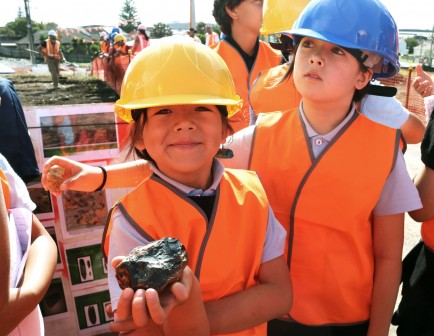Recent archaeological discoveries in Edmonton Avenue, Oranga have provided an exciting opportunity for local students to learn, celebrate and connect with the place they call home.
On Tuesday 10 March, over 100 Te Papapa School students donned hi-vis and hard hats before taking a journey back in time to around 1700—when Oranga was home to a thriving kumara growing region.
The Oranga Development team partnered with archaeologists Dr Hans-Dieter Bader and Rose Young, Piritahi, and Kaitiaki - Te Ākitai Waiohua Iwi Authority Jeff Lee to share this slice of history with the next generation.
Dr Bader and Mr Young guided the students through stories of the time when the site was used as a camp during planting and harvesting of kumara.
“The discovery of empty shells, ash from fires, fish bones and remnants of a small whare during demolition have provided an important physical link to the oral stories of Oranga,” explained Dr Bader.
“Evidence of ‘post holes’ in the ground tells us that wooden shelters once offered protection to ancestors who ate fish and shellfish from the nearby Manukau Harbour on this site. This also explains the discovery of empty shells, fish bones and ash piled up on a rubbish mound next to the shelters.”
“Discoveries such as this give real context to traditional spoken stories. In turn, these stories weave into a much wider narrative around the history of indigenous New Zealanders.” he said.
The Edmonton Avenue site joins the discovery of more than 10 separate planting locations in three clusters across Oranga, providing specific locations and details around the distribution of Maori garden beds and the rich kumara growing origins of the area.
“It was such a pleasure to share this discovery with local students and help build their sense of place by giving them a connection to the past,” said McKenzie Tuala-Pine, Placemaking Advisor.
“Last year, a similar discovery activity was held with May Road School students in Mt Roskill, and its success has paved the way for Te Papapa School and future school-based opportunities.
“We’re committed to enhancing social and cultural wellbeing within our communities, and to upholding our principle of Tuku Iho – ‘the whakapapa of the whenua, iwi and hāpu are acknowledged, celebrated and protected’.
“Helping preserve Oranga’s cultural footprint and local indigenous stories is something we’re proud to be part of,” she said.
Kāinga Ora and Piritahi work closely with Dr Bader and the Archaeology Solutions team when civil works result in an archaeological discovery.
In Oranga, highly technical documentation methods and photogrammetry from drone flights were used to study the site. This allowed archaeologists to document, map and publish the features in a short time; minimising disruption to the construction schedule.
The unearthed artefacts have now been formally recorded, and the team is considering options to commemorate the site and share Oranga’s proud heritage with the wider community.
